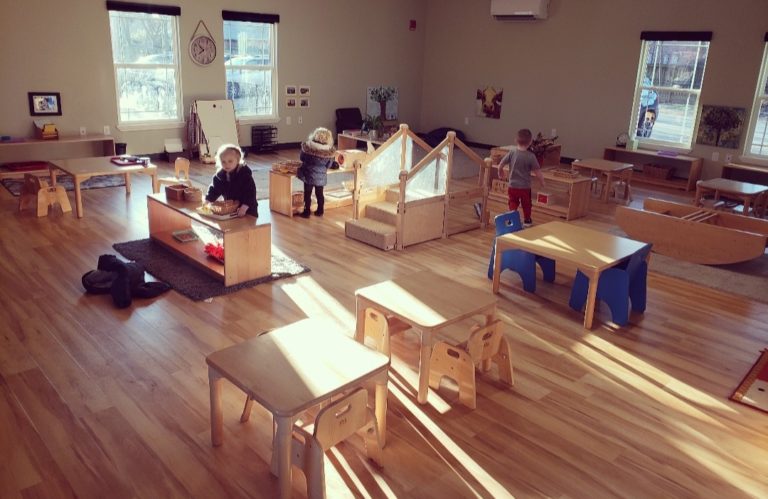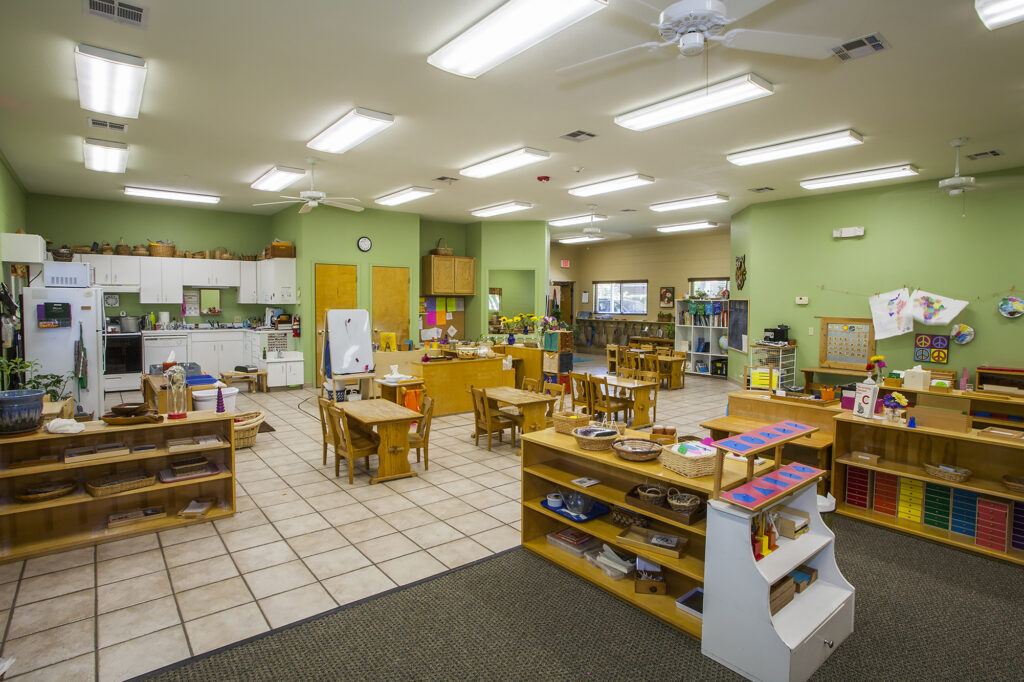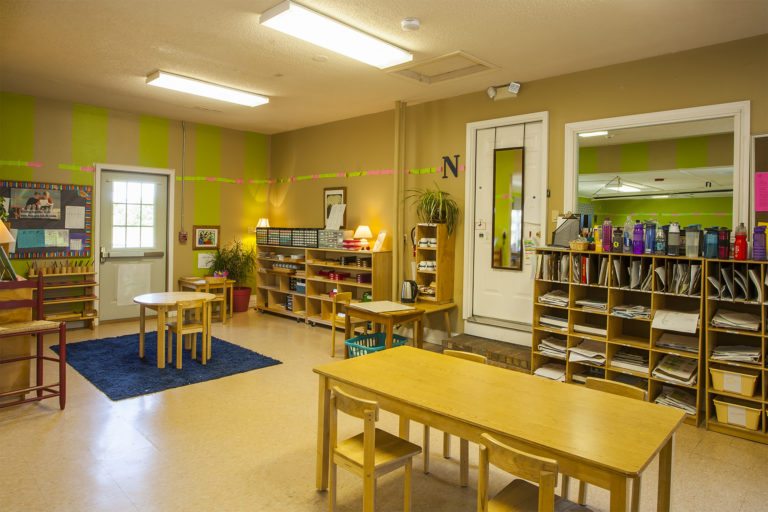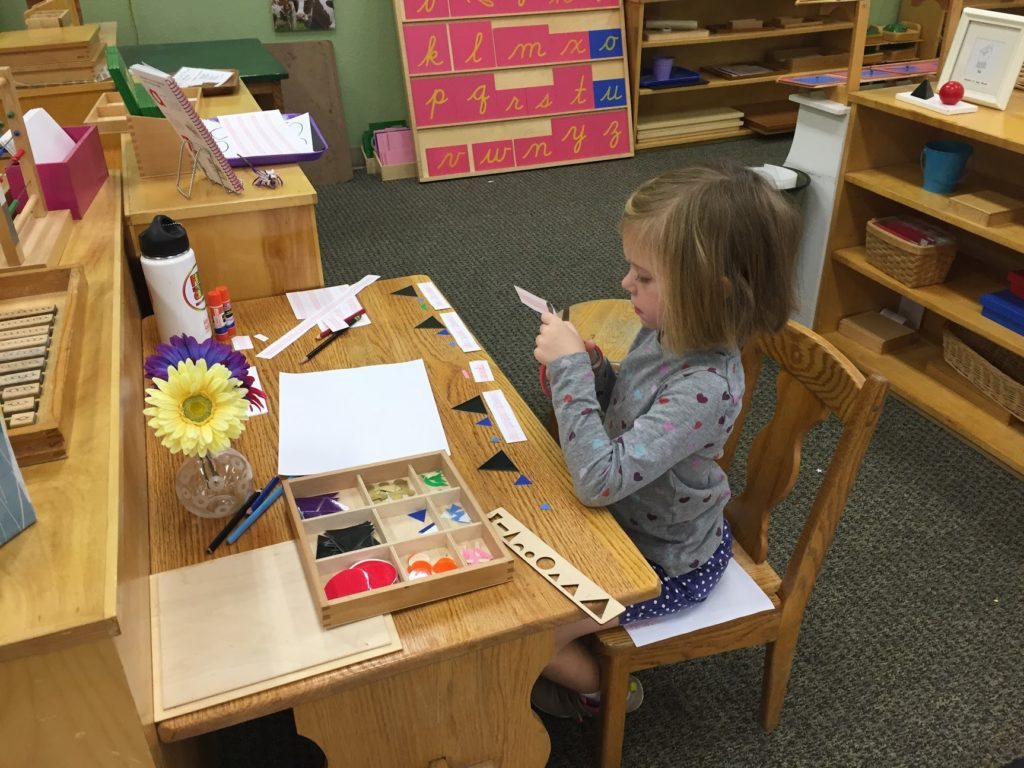Montessori Classroom Approach
Characteristics of a Montessori Classroom:
- Beautiful: inviting students to work
- Thoughtfully arranged: to accommodate the student’s plane of development and engagement with the environment
- Uncluttered, calming spaces: to promote focus and concentration
- Learning materials displayed on accessible shelves: to foster independence and work flow
- Everything in its place: to foster harmony and order that will comfort, calm, and inspire
- Safe and empowering: to produce the joy of learning
Inside the Montessori Classroom
Classroom Design
The design and flow of the Montessori classroom create a learning environment that accommodates choice.
There are spaces suited to group activity, and areas where a student can settle in alone. Parts of the room are open and spacious, allowing a primary student to lay out strands of beads for counting, or an elementary student to ponder a 10-foot-long Timeline of Life.
You won’t find the customary rows of school desks; children work at tables or on the floor, rolling out mats on which to work and define their work space.
Nor are you likely to find walls papered with brightly colored images of cartoons and syndicated characters. Rather, you might see posters from a local museum, or framed photographs or paintings created by the students themselves.



There are well-defined spaces for each part of the curriculum, such as Language Arts, Math, and Culture. Each of these areas features shelves or display tables with a variety of inviting materials from which students can choose.
Many classrooms have an area devoted to peace and reflection: a quiet corner or table with well-chosen items such as—a vase of flowers, beautiful art, or a class pet—to lead a child to meditative thought.
And always there are places to curl up with books, where a student can read or be read to.
Each classroom is uniquely suited to the needs of its students. Primary rooms feature low sinks, chairs, and tables; a reading corner, reachable shelves, and child-sized materials in all domains of the curriculum—elements that allow independence and help develop small motor skills. In the lower elementary classroom, you’re likely to see large tables for group work, child-sized materials in all domains of the curriculum, and open spaces for group work on rugs.
Above all, each classroom is warm, well-organized, inviting and arranged to optimize the learning experience for students.
Montessori Learning Materials
A hallmark of Montessori education is its hands-on approach to learning. Students work with specially designed materials, manipulating and investigating until they master the lesson inside. Designed with the child’s plane of brain development in mind, Montessori materials are:
- Beautifully crafted to draw the child to the work
- Displayed on open, easily accessible shelves
- Arranged (left to right, as we read in Western languages)
- Sequenced from the simplest to the most complex
Each material teaches a single skill or concept at a time—for example, the various “dressing frames” help toddlers learn to button, zip, and tie; 3-dimensional grammar symbols help elementary students analyze sentence structure and style. And, built into many of the materials is a mechanism (“control of error”) for providing the student with some way of assessing her progress and correcting her mistakes, independent of the teacher.
The concrete materials provide passages to abstraction, and introduce concepts that become increasingly complex. As the members of the class progress through the curriculum, the teacher replaces some materials with others, ensuring that the level of challenge continues to meets their needs.

The Teacher as "Guide"
The Montessori teacher, child, and environment may be seen as a learning triangle, with each element inextricably linked, and a vital part of the whole. The teacher thoughtfully prepares a classroom environment with materials and activities that entice her students to learn. She may guide her students to new lessons and challenges, but it is the child’s interaction with what the environment has to offer that enables learning to occur.
Because the teacher isn’t meant as the focus of attention, he can often be difficult to spot. Typically, you’ll find her sitting on the floor or at a table giving a lesson, observing his students as they work and making notations about their progress, or consulting with an individual or a small group.
Multi-Age Groupings
A Montessori class is composed of students whose ages typically span 3 years. Ideally, members stay with the class for the entire cycle, forging a stable community and meaningful bonds.
It is common to see students of different ages working together. Older students enjoy mentoring their younger classmates—sometimes the best teacher is someone who has recently mastered the task at hand. Younger students look up to their big “brothers” and “sisters,” and get a preview of the alluring work to come.
A Caring Community
The Montessori classroom radiates harmony and respect. Students are encouraged to view their classroom as a community of learners. As each student progresses through the 3-year cycle, our hope is that students understand:
- I am a member of this community.
- I am a contributor to this community.
- I am a leader within this community.
Teachers and assistants model to students daily how to address other members of the classroom community with respect. Students show grace and courtesy, and an interest in the welfare of others. “Let me help!” is a common classroom refrain. There is a busy hum of activity, yet also a profound respect for silence.
Students work together as stewards of their environment. They take turns caring for classroom pets and plants; do their part to maintain order, such as by returning materials to the shelves after use; and help keep outdoor spaces groomed and litter-free.
How to live in community, to learn independently, to think constructively and creatively: These are the lessons of the Montessori classroom that remain with its students as they make their way in the world.
Information derived from American Montessori Society.

